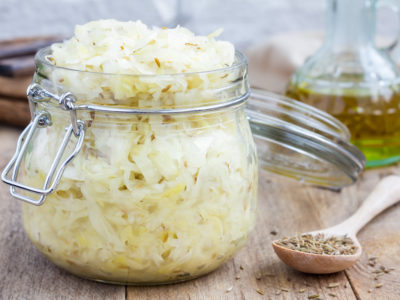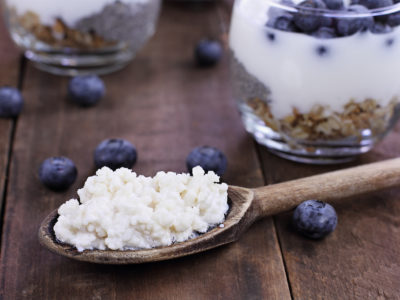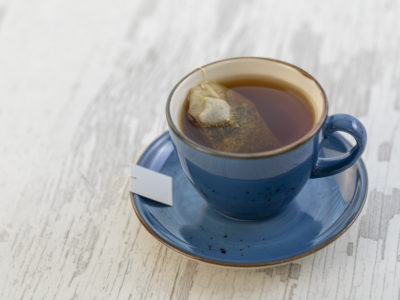Table of Contents[Hide][Show]
Kombucha Tea Is the “Elixir of Life”
SCOBY kombucha is a popular fermented beverage. This superfood tea has been consumed for thousands of years and can help with gut health, your immune system, and so much more.
Kombucha is a live-cultured vinegary, sour, and sweet tea that’s often bubbly. It is simply made from:
- Black, white, or green tea
- Cane sugar (preferably organic cane sugar)
- Bacteria/yeast or SCOBY
If you close your eyes, it can resemble the taste of dry champagne. With hints of spices, fruits, and herbs, it can even pass for a sweet-tart soda.
Kombucha satisfies our need for a sparkling beverage while being health conscious.
What Is SCOBY Kombucha?
SCOBY is an acronym for the symbiotic culture of bacteria and yeast. It’s called the kombucha mother because it’s the main ingredient used in the fermentation process. The SCOBY also protects the kombucha as it ferments. These beneficial bacterial colonies grow in a flat, gooey cellulose “pancake” on the top of the brew that resembles a slimy brownish mushroom.
This amazing living organism transforms sugary tea into a live fermented food for us to consume. Under the right conditions, these bacteria promote a product that has so much disease-fighting potential.
Each batch of kombucha has different strains and healing abilities depending on its origins. SCOBY kombucha is admired by many because it can help with digestion and joint health, and it is jam-packed with probiotics and antioxidants.
It boasts of superior health benefits with only a few drinks per week. Fermented foods are great because when foods are partially broken down, it makes the nutrients more bioavailable.
If you need a midday pick-me-up, say goodbye to coffee and hello to a natural energy-packed drink loaded with vitamins, minerals, and enzymes.
Related
12 Caffeine Alternatives for a Natural Energy Boost
Increase your energy levels throughout the day with these caffeine alternatives. As an added bonus to drinking less caffeine, these substitutes have plenty of added health benefits that might make you think twice next time you reach for another cup of Joe!
Fresh SCOBY Feeds the Gut
Humans are populated with bacteria, estimated at one human cell to every 3 of bacteria. “Good bugs” or beneficial bacteria are what we need to keep a balanced microbiome.
Ideally, we are 85% beneficial bacteria and 15% bad bacteria. These good bacteria are what keeps our guts healthy and helps improve immune function.
Globally, we are all still recovering from an age of hand-sanitizing madness. As an unfortunate byproduct, we are killing too much of our good bacteria when we kill off the bad with antibacterial soaps and antibiotics.
SCOBY kombucha can be an excellent way to repopulate your body with good bacteria. Modern diets filled with added sugars can cause your microbiome to get out of balance and overgrow the bad (pathogenic) bacteria. That’s why all of us could benefit from the extra boost that kombucha can deliver.
Health Benefits of SCOBY Kombucha
The value of a SCOBY kombucha bottle goes beyond its fizz or taste. Here are some of the health benefits of delicious kombucha tea.
1. Digestion
The drink is packed with probiotics, which is the key to gut health. Enzymes like glucaric and lactic acid increase digestion.
Kombucha can crowd out the bad bacteria by populating beneficial bacteria. Research shows that healthy populations of beneficial bacteria can help a host of ailments and illnesses, including leaky gut and possible healing of gastric ulcers.
2. Antioxidants
SCOBY kombucha is made with black tea, which contains polyphenols that can also help with weight loss. It is also chock full of B vitamins, vitamin E, vitamin A, vitamin C, and beta-carotene.
Related
Probiotic Tea: Everything You Need to Know
In this post, we’ll answer all your questions about probiotic tea, including what’s in it and how it can support both the digestive system and immune health.
3. Detoxification
Glucaric acid is a component that research has shown to prevent cancer and support the natural cleaning of the body. It also has gluconic acid, which may help fight certain pathogens such as those that cause food-borne illnesses, according to 2009 research.
4. Joint Health
SCOBY kombucha contains glucosamine, amino acids, and hyaluronic acid that are great for joint health. A 2018 review of the different studies involving glucosamine showed it may help improve the stiffness of the joints, which is a common symptom of arthritis.
5. Circulation
Lactic acid assists in blood circulation along with raising alkaline pH. According to a 1990 study, lactic acid bacteria may also improve lactose intolerance, regulate cholesterol, and control gut infections.
6. Alkaline pH
Although kombucha is acidic, it is alkaline in the body like lemons. This can be very beneficial to the body as higher alkalinity is associated with better health, while higher acidity is associated with increased inflammation.
7. Immune System
70–80 of your immune function takes place in the gut. Therefore, no other mechanism in the body can have a greater impact on your immune function and overall health. When you support your body with beneficial bacteria—via kombucha, gut-healthy foods, or a proven probiotic supplement—you’re bolstering your body’s ability to stay healthy.
8. Mental Health
Probiotics lead to positive mood changes by improving brain function. Increased beneficial bacteria in your gut helps your body produce neurochemicals that relieve anxiety with B vitamins such as:
- B1 (thiamine)
- B2 (riboflavin)
- B3 (niacin)
- B6
- B9 (folic acid)
- B12
Probiotics are also known to be effective for a whole host of other health problems, including:
- Diabetes
- Kidney toxicity
- Obesity
- Endothelial function
- Atherosclerosis
- Hypertension
- Anemia
- Liver and kidney function
- Nervous system
- Asthma
- Cancer
- Acne
- Arthritis pain
Not a Cure-All
Kombucha can’t take all of the credit for single handedly curing diseases, and it will not keep your hair from turning gray.
If you have a serious health issue, it is always best to consult your doctor. If you struggle with SIBO or have yeast intolerances, mold allergies, blocked detox pathways, and methylation issues, you can experience negative side effects from fermented foods like kombucha.
So put your drink down if you get a headache, stomachache, or feel dizzy. Trust your body; if it doesn’t feel good, don’t drink it.
After resolving some of these health issues, you can try to slowly reintroduce kombucha after about six months, starting with a few ounces to see how it affects you.
Home Brewing and Kombucha Recipe
You can learn SCOBY kombucha brewing and have your favorite fermented drink anytime. Bacteria love to multiply which makes this an easy DIY project, similar to making sourdough.
All you need for making kombucha at home is a sterile glass jar, non-herbal tea, cane sugar (organic is preferable), clean cloth to keep out fruit flies, and clean water. If you use quality ingredients and water free of fluoride and chlorine, you are good to go. It’s easy to brew kombucha, especially if you’re already used to brewing regular tea.
- Bring a quart of water and a cup of sugar to boil in a saucepan. Add 4-6 tsp of tea or 4-6 loose leaf tea bags and steep for 5-15 mins.
- Remove tea bags and add mixture to a glass gallon jar and fill with room temp water.
- Add your SCOBY (if it’s your first batch, here’s a kombucha culture for starter tea) and approximately 1/2 cup of the liquid from the previous kombucha brew.
- Cover the top of the jar with a breathable cotton cloth (but not a cheesecloth), double layer of paper towels, or coffee filter and secure with a rubber band.
- Wait for 7-14 days depending on temperature. Allow the mixture to rest in a warm place between 60 to 85 degrees F out of direct sunlight. Between 2.8 and 3.4 pH is your target.
- Decant into liquid, pour into clean jars, and refrigerate your finished kombucha.
- Reserve 1/2 cup of the liquid and your new SCOBY to start your next batch.
- Give the “baby” or multiplied SCOBY to a friend, or save it for yourself in a “SCOBY hotel” in your fridge!
Tips:
- Make sure to throw it out if you see any black stuff. That would be mold.
- You can also use distilled wine vinegar as your starter liquid.
- If you cannot find cane sugar, white sugar or granulated sugar may also be a substitute.
Once the fermenting process is done, you can also add flavoring agents as you see fit to give your own SCOBY kombucha a little something extra!
If home-brewing is not your cup of tea, not to worry, there is an abundance of delicious and healthy kombucha brands on the market today. For commercial kombucha, make sure whatever you choose has raw or live cultures.
Pasteurization may taste just as good, but it will be void of the probiotic health benefits. Sugar contents can be high, so check for one with five grams or less per serving.
Interesting Facts About SCOBY Kombucha
To help you appreciate the SCOBY culture more, here are some cool facts:
- The origins of kombucha are as mysterious as its appearance. “The tea of immortality” is thought to have originated in 221 BC during the Chinese Tsin dynasty, though it only gained popularity in the United States during the 1990s.
- Its Asian roots traveled to Japan as “cha” literally means “tea” in Japanese, though “kocha-kinoko” is what the Japanese call kombucha, which literally means “tea mushroom.”
- You can use kombucha as a mixer for that sour taste in a mixed drink for your next party.
- If you dare, instead of throwing away your baby SCOBY, you can cut it up and eat it in a salad.
- Kombucha is a tasty probiotic-rich fermented tea populating health food stores as well as our gut.
- Although kombucha contains alcohol, it’s usually not high enough to make you drunk.
- Some people confuse SCOBY with apple cider vinegar mother, but they’re not the same.
Kombucha and Secondary Fermentation
The recipe above is for brewing with SCOBY kombucha. With it, you can now drink the healthy tea anytime you want, or you can let it undergo secondary fermentation.
Secondary fermentation can produce a more acidic version of the tea. It’s great for those who want to tame the sweetness or give more texture to the drink.
It’s a simple process:
- Remove the kombucha starter culture or the SCOBY as well as at least a half cup of the liquid. Place the SCOBY on a clean plate.
- After scooping SCOBY and the liquid, you can now transfer the remaining fluids to another bottle using a woven cloth to make sure you trap the solids.
- Then, you can create several herbal teas from the original kombucha by adding your favorite flavors.
- Place the add-in flavors at the bottom of the bottles or jars.
- Slowly pour the liquids and cover the bottles tightly.
- Store it between two and fourteen days. You may shorten the process if the bottles are at room temperature or in a hot area.
- In the meantime, you can place the SCOBY and the fluid in another glass jar in case you want to brew a new batch of kombucha.
Choosing Your Flavors
The homemade kombucha SCOBY recipe above will give you unflavored kombucha. You can, however, play around with its flavors and make a variety of herbal kombucha teas at home.
Another option is to add plant and bean extracts, dried fruits, and candied ginger. Your choice of tea leaves can also influence the taste.
Although most SCOBY kombucha teas use black tea, you can also make use of green, white, and oolong teas, among others. Using green tea can give your kombucha a delicate fruity taste, while white tea may provide you with a flowery taste and aroma.
You may also use alkaline greens to further increase the antioxidants present in every bottle. Another option is to add these every time you serve yourself a cup of kombucha tea.
SCOBY kombucha is a beautiful adventure for your taste buds. Go out and try some of this accessible, energizing, fizzy probiotic drink.
You can even swap out a soda or two for the added health benefits. Kick back and try out blueberry and cinnamon, ginger, or a mango habanero kombucha.
Give it a try, and see what you think. It is bound to grow on you.
You May Also Like…
Editor’s Note: This post was originally published onFebruary 21, 2017, and has been updated for quality and relevancy most recently on July 22, 2021.






